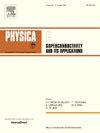Superconductivity in cuprates with planar oxygen vacancies and apical oxygen vacancies
IF 1
3区 物理与天体物理
Q4 PHYSICS, APPLIED
Physica C-superconductivity and Its Applications
Pub Date : 2025-08-29
DOI:10.1016/j.physc.2025.1354788
引用次数: 0
Abstract
In this article, we demonstrate superconductivity of cuprates with oxygen deficiency in copper-oxygen planes and apical positions by checking Zhang-Rice singlets (ZRS’s) formation. The oxygen vacancies have different effects on critical temperature (Tc) evolution in underdoped regime and overdoped regime respectively. In the underdoped regime, the oxygen vacancies damage the ZRS formation on its adjacent Cu atoms and suppress the superconductivity identical to effects of impurity substitutions of Cu atoms. However, in the overdoped regime, the oxygen vacancies enhance the Tc which increases with increase of concentration of the oxygen vacancies. The superconductivity persists when the concentration of the oxygen vacancies is larger than 0.50 (per Cu atom) in the copper-oxygen plane. Effects of planar oxygen vacancies and apical vacancies with various concentrations have been examined. The superconductivity in the highly overdoped regime (doping level spans from 0.27 to 0.80) has been predicted. It suggests a new method to discover the new superconductors. Our results can explain post-annealing-induced enhancement of the Tc from 70 K to above 90 K in Sr2CuO3+δ with the oxygen vacancies in the copper-oxygen plane and the apical positions.
具有平面氧空位和顶端氧空位的铜酸盐的超导性
在这篇文章中,我们通过检查张-米单线(ZRS)的形成,证明了铜酸盐在铜氧平面和顶端位置缺氧时的超导性。氧空位对欠掺杂和过掺杂的临界温度演化有不同的影响。在欠掺杂状态下,氧空位破坏了相邻Cu原子上的ZRS形成,抑制了超导性,与杂质取代Cu原子的影响相同。而在过掺杂状态下,氧空位增加了Tc, Tc随氧空位浓度的增加而增加。当氧空位浓度大于0.50(每个Cu原子)时,铜-氧平面上的超导性持续存在。研究了不同浓度对平面氧空位和根尖氧空位的影响。预测了高掺区(掺杂水平为0.27 ~ 0.80)的超导性。它提出了一种发现新超导体的新方法。我们的结果可以解释Sr2CuO3+δ中Tc从70 K到90 K以上的退火诱导增强与铜氧平面和顶端位置的氧空位有关。
本文章由计算机程序翻译,如有差异,请以英文原文为准。
求助全文
约1分钟内获得全文
求助全文
来源期刊
CiteScore
2.70
自引率
11.80%
发文量
102
审稿时长
66 days
期刊介绍:
Physica C (Superconductivity and its Applications) publishes peer-reviewed papers on novel developments in the field of superconductivity. Topics include discovery of new superconducting materials and elucidation of their mechanisms, physics of vortex matter, enhancement of critical properties of superconductors, identification of novel properties and processing methods that improve their performance and promote new routes to applications of superconductivity.
The main goal of the journal is to publish:
1. Papers that substantially increase the understanding of the fundamental aspects and mechanisms of superconductivity and vortex matter through theoretical and experimental methods.
2. Papers that report on novel physical properties and processing of materials that substantially enhance their critical performance.
3. Papers that promote new or improved routes to applications of superconductivity and/or superconducting materials, and proof-of-concept novel proto-type superconducting devices.
The editors of the journal will select papers that are well written and based on thorough research that provide truly novel insights.

 求助内容:
求助内容: 应助结果提醒方式:
应助结果提醒方式:


